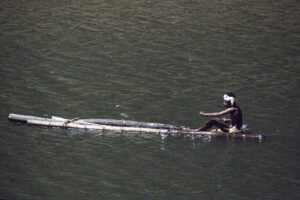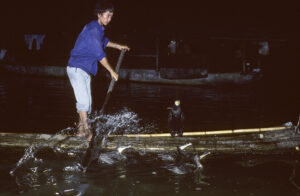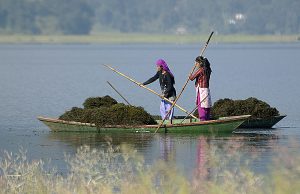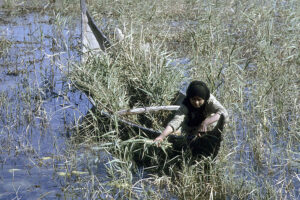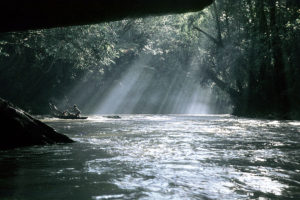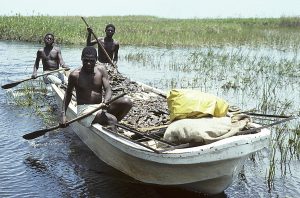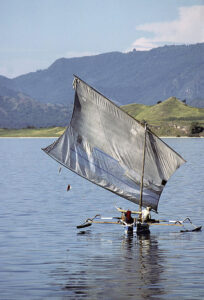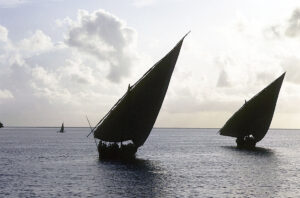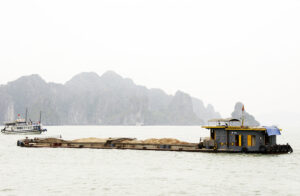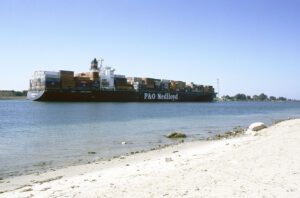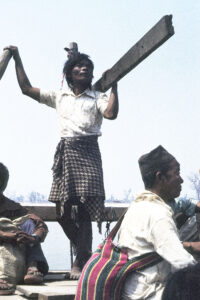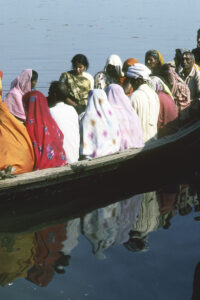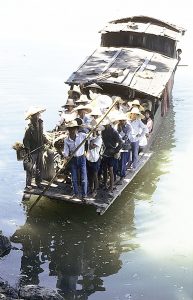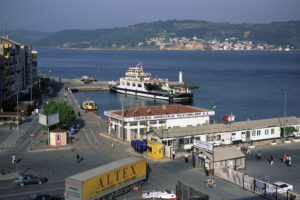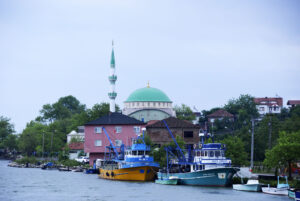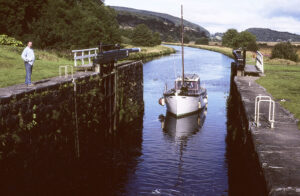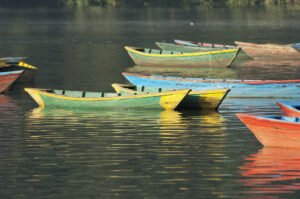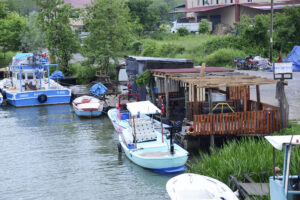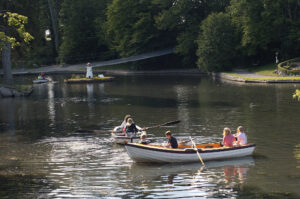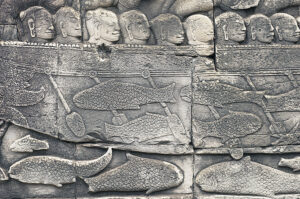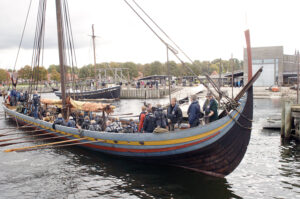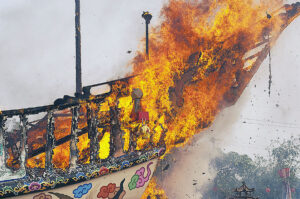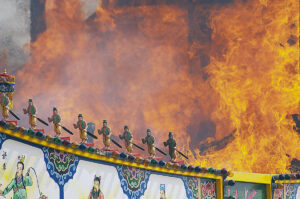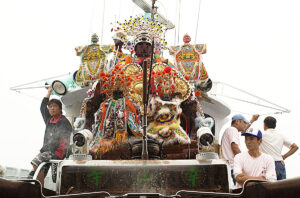Boats and ships
Dawn at the Ganges River, Varanasi, Uttar Pradesh, India. For Hindus, this river is the most sacred of all. Other pictures from this river are shown elsewhere on this page, and the river is described in depth on the page Religion: Hinduism. (Photo copyright © by Kaj Halberg)
Boy, punting a dugout along a small stream near Gemena, Zaire. (Photo copyright © by Kaj Halberg)
Punting a boat along a watercourse at the outskirts of a large marshland, named Cao Hai (‘Grass Sea’), Guizhou Province, China. (Photo copyright © by Kaj Halberg)
Fisherman, wading out to his boat, Nissum Fjord, Denmark. (Photo copyright © by Kaj Halberg)
This ship in the Suez Canal is partly hidden behind a sand bar, creating an illusion of containers, being transported on board a train. The Attaqa Mountains are seen in the background. (Photo copyright © by Kaj Halberg)
Sailboat on the Seine River, Paris. (Photo copyright © by Kaj Halberg)
Boats have been used since prehistoric times, maybe as early as a million years ago. The first ’boats’ were probably floating tree trunks, on which early people were able to cross streams.
At an early stage, boats were depicted by pre-historic men, as petroglyphs or cave paintings.
This ancient cave painting, depicting people and boats, is situated in the so-called Painted Cave, Niah National Park, Sarawak, Borneo. (Photo copyright © by Kaj Halberg)
Bronze Age petroglyphs are very common in Scandinavia. Two examples, depicting boats, are shown below, from Bohuslän, Sweden. In the lower picture, two men are in battle. The animal depicted in the upper left corner is a reindeer (Rangifer tarandus), described on the page Animals – Mammals: Deer.
Other pictures from the same area may be seen on the page Culture: Folk art around the world.
(Photos copyright © by Kaj Halberg)
Rafts and reed boats
The earliest constructed type of ‘boat’ was probably the raft – a flat-bottomed vessel, consisting of light tree trunks, bamboo stems, or other materials, tied together with liana strips or twine.
Tribal, paddling his bamboo raft across Lake Periyar, Kerala, India. (Photo copyright © by Kaj Halberg)
Bamboo raft on the Li River, Guangxi Province, southern China. (Photo copyright © by Kaj Halberg)
At night, this young man is paddling his bamboo raft down the Li River, while his tamed great cormorants (Phalacrocorax carbo ssp. sinensis) are catching fish for him. For thousands of years, Chinese and Japanese fishermen have used these birds for fishing. Various cormorant species are described on the page Fishing. (Photo copyright © by Kaj Halberg)
The simple ‘boat’ in the foreground consists of logs, tied together, Karativu, western Sri Lanka. (Photo copyright © by Kaj Halberg)
A special type of raft is the reed boat, constructed of bundles of bulrush (Schoenoplectus), papyrus (Cyperus papyrus), or reed (Phragmites australis), bound together with rope or bark strips. The earliest remains of a reed boat were excavated in Kuwait, dating back c. 7,000 years.
Reed boats were common in Ancient Egypt and Mesopotamia, on Lake Tana in Ethiopia, and Lake Titicaca in South America, and probably also on Easter Island. They are still used by the Uru people on Lake Titicaca and on Lake Tana.
This relief in the Horus Temple, Edfu, Egypt, probably depicts a reed boat, highly swung at bow and stern, which are shaped as images of Horus, one of the most important deities of the Egyptian pantheon. Note that the image of the boat is repeated at a smaller scale. The birds above the boat are Egyptian vultures (Neophron percnopterus), which was regarded as a deity, named Nekhbet, nurse of the Pharaohs. (Photo copyright © by Kaj Halberg)
On Lake Tana, reed boats have been made from papyrus stems since the 9th Century B.C., or earlier. This girl is punting a very simple papyrus boat, merely consisting of a bundle of papyrus, tied together. (Photo copyright © by Kaj Halberg)
Papyrus boats, however, can also be of considerable size, carrying huge loads, as this one on Lake Tana, heavily laden with fodder. A huge growth of papyrus is seen in the background. (Photo copyright © by Kaj Halberg)
Dugouts and other early canoe types
The first manufactured true boats were dugout canoes, made by hollowing out a tree trunk, using ax or fire, or both. The oldest excavated dugout canoe dates from c. 8000 B.C., but they must surely have been in use much earlier than that. Today, they are still in use in many places.
Canoes, made from birch bark or animal hides, tied to a light wooden frame, were used at a very early stage in the Americas and in the Arctic.
This man is paddling his dugout canoe past rocks at Otter Point, Lake Malawi. (Photo copyright © by Kaj Halberg)
Fishermen and dugout canoes on the shore of Lake Lutamba, southern Tanzania. The birds are hamerkop (Scopus umbretta), probably hoping for some tidbits. This bird is described on the page Fishing. (Photo copyright © by Kaj Halberg)
This boy has paddled his dugout canoe, laden with a few mango fruits, out to a ferry on Lake Malawi, and now a furious haggling over the price will begin. – My trip with this ferry is related on the page Travel episodes – Malawi 1997: A three-day ferry cruise on Lake Malawi. (Photo copyright © by Kaj Halberg)
The catch of the day has been placed in a dugout canoe, Lochinwar National Park, Zambia. (Photo copyright © by Kaj Halberg)
These men in the town of Samfya, northern Zambia, are carving a dug-out canoe from a eucalyptus trunk. (Photo copyright © by Kaj Halberg)
In this picture from Itsoundzou, Grande Comore, Comoro Islands, a dugout canoe is being repaired by filling it with water to soften the wood, which can then be reshaped. The coconuts a placed in the water to take up space, so that less water has to be poured into the boat. (Photo copyright © by Kaj Halberg)
Canoes and other smaller boat types
At a later stage, humans learned to make boats by combining planks and caulking the seams with grass ropes, tar, or other materials.
This man is heating up tar to be applied to the bottom of a boat, marshes of southern Iraq. (Photo copyright © by Kaj Halberg)
Boat on the Ayeyarwadi (Irrawaddy) River, Bagan, Myanmar. The Buddhist Lawkananda Pagoda is seen in the background. (Photo copyright © by Kaj Halberg)
Traffic on the Ayeyarwadi River at sunset. (Photos copyright © by Kaj Halberg)
Women, fishing up water plants to be used as fodder for their cattle, Phewa Lake, Pokhara, Nepal. (Photos copyright © by Kaj Halberg)
The main thoroughfare through the town of Nyaung Shwe, Myanmar, is a canal, leading out to Lake Inle. Transportation of passengers and goods mainly take place in longboats with outboard engines, whisking the water into high plumes. (Photos copyright © by Kaj Halberg)
Canoe, negotiating rapids on the Oubangui River, Central African Republic. The land on the far side of the river is part of Zaire. (Photo copyright © by Kaj Halberg)
Inthe man from the village of Nanthe, Lake Inle, Myanmar, bringing home a huge load of grass, paddling his canoe with one leg – a style typical of this area. (Photo copyright © by Kaj Halberg)
This man punted a boat across a river in Manas National Park, Assam, India, so that we could search for the golden langur (Trachypithecus geei). This rare monkey is described on the page Animals – Mammals: Mammals in the Indiean Subcontinent. (Photo copyright © by Kaj Halberg)
This man is punting a boat with water plants, to be used as fodder, Cao Hai Lake, Guizhou Province, China. (Photo copyright © by Kaj Halberg)
Boats in morning light, Ganges River, India. (Photo copyright © by Kaj Halberg)
Boats in a mangrove swamp, Monterrico, Guatemala. (Photo copyright © by Kaj Halberg)
Tourists, enjoying a boat trip down the Rapti River, searching for crocodiles, Chitwan National Park, Nepal. (Photo copyright © by Kaj Halberg)
A diminutive sailboat in the passage, leading into the city of Kochi, Kerala, India. (Photo copyright © by Kaj Halberg)
Boat, Özlüce, west of Inebolu, Black Sea, Turkey. (Photo copyright © by Kaj Halberg)
Boat, laden with firewood, Lake Phewa, Pokhara, Nepal. (Photo copyright © by Kaj Halberg)
In Ancient Egypt, reed boats were succeeded by a small type of sailboat, the felucca.
Feluccas are still a very common sight on the Nile. (Photos copyright © by Kaj Halberg)
For thousands of years, a huge marsh area in southern Iraq, between the Euphrates and Tigris Rivers, was the home of the Madan tribe, whose way of life was completely adapted to the wet habitat. The common means of transportation was a slender type of canoe, called meshof. Their reed houses were built on islets in the marshes, and they made a living by hunting and fishing, growing rice, and raising water buffaloes.
The regime of Saddam Hussein Abd al-Majid al-Tikriti (1979-2003) put an end to their way of life by draining the marshes, as a retaliation for the Madan siding with the Americans during the First Gulf War (1990-1991).
This interesting wetland is presented in depth on the pages Travel episodes – Iraq 1973: The hospitable mudir, and Iraq 1973: Dust storm and sheep’s head.
A typical Madan dwelling, with houses constructed of reeds. In the foreground meshofs, in the background date palms (Phoenix dactylifera). (Photo copyright © by Kaj Halberg)

Meshofs and mats, made from reeds, in front of a Madan dwelling. (Photo copyright © by Kaj Halberg)
Madan people, transporting a load of harvested reeds in a meshof, near Al-Sabel. (Photo copyright © by Kaj Halberg)
Madan children learned to paddle a meshof from a very young age. (Photo copyright © by Kaj Halberg)
Madan girl, harvesting reeds for cattle fodder, using a sickle. (Photo copyright © by Kaj Halberg)
In the Kashmir Valley, northern India, lakes and canals constitute important waterways for transportation of goods.
Early in the morning, this man is paddling his boat across Dal Lake. (Photo copyright © by Kaj Halberg)
Movable grocery stores. – Vendors paddling their boats, laden with goods, from one houseboat to the next, Lake Nagin. (Photos copyright © by Kaj Halberg)
Traffic on one of the main channels through the city of Srinagar. (Photos copyright © by Kaj Halberg)
Boy in a boat, Dal Lake. (Foto copyright © by Kaj Halberg)
This man and his daughters are on their way across Dal Lake. (Photo copyright © by Kaj Halberg)
A canoe on Dal Lake, heavily laden with fodder. (Photo copyright © by Kaj Halberg)
Women, collecting water lilies (Nymphaea) for fodder, Dal Lake. (Photo copyright © by Kaj Halberg)
Little boy – large canoe, Lake Nagin. (Photo copyright © by Kaj Halberg)
Van Long Nature Reserve is a large wetland in northern Vietnam. This reserve is renowned for its population of Delacour’s langur (Trachypithecus delacouri). This monkey is critically endangered, mainly due to loss of suitable habitat, and also illegal collecting for traditional medicine. In 2010, it was estimated that fewer than 250 individuals were remaining in the wild. Van Long is the area in Vietnam with the only viable population. Pictures, depicting this species, are shown on the page Animals – Mammals: Monkeys and apes.
A long row of bamboo boats, utilized to row tourists into the Van Long Nature Reserve. (Photo copyright © by Kaj Halberg)
This woman took me into the reserve. (Photos copyright © by Kaj Halberg)
Borneo is inhabited by several Malayan tribes, known by the common name Dayaks, including Punan, Iban, Kayan, Kelabit, and Penan. My adventures among Punan people are related on the page Travel episodes – Borneo 1975: Canoe trip with Punan tribals.
Punan men, punting their canoes, called perahu, up the Ba River, a tributary to the mighty Rajang River, Sarawak, Borneo. (Photos copyright © by Kaj Halberg)
The Unga are a Bantu people, who live on islands in the great Bangweulu Swamps, northern Zambia. Their main occupation is fishing, and they also grow manioc, or kassava (Manihot esculenta), besides collecting a number of wild plants, such as rhizomes of water-lilies (Nymphaea) and roots of papyrus (Cyperus papyrus). They also hunt birds and antelope.
The ways of the Unga people are described in depth on the page Countries and places: Bangweulu – where water meets the sky.
The only mode of transportation in the Bangweulu Swamps is by boat. This boy is punting a canoe along a channel in vegetation, consisting of papyrus (Cyperus papyrus), reed (Phragmites australis), and other species. (Photo copyright © by Kaj Halberg)
Unga fishermen, hauling up their nets. (Photos copyright © by Kaj Halberg)
Unga men, bringing a load of dried fish to a market near the swamps. The boat is a so-called banana boat, named for its shape. (Photo copyright © by Kaj Halberg)
A sick Unga man is taken by boat to a local hospital. (Photo copyright © by Kaj Halberg)
Unga boys have made this toy boat out of clay. (Photo copyright © by Kaj Halberg)
Tonle Sap in Cambodia is the largest lake in Southeast Asia. This lake is home to a rather large group of Vietnamese, living in so-called ‘floating villages’ – houses built on pontoons or rafts, anchored to the lake bottom. Other pictures from this area may be seen on the page Culture: A place to live.
Boats in a Vietnamese ‘floating village’, Tonle Sap. (Photos copyright © by Kaj Halberg)
Women, paddling boats down a river near Tonle Sap. (Photo copyright © by Kaj Halberg)
The Batak are a group of closely related Austronesian peoples, including the Karo, Pakpak, Simalungun, Toba, Angkola, and Mandailing, who live in a large area of northern Sumatra, Indonesia. My acquaintance with these people stems from a visit to Lake Toba in 1975.
Other pictures, depicting Batak people, may be seen on several other pages on this website, including People: Children around the world, Culture: Musicians, and Portraits.
Batak tribal boy, paddling a canoe, Pangururan, Samosir, Lake Toba. (Photo copyright © by Kaj Halberg)
Outriggers
This is a boat type, where a slender log is placed parallel to the main hull on one side and attached to it by two curved branches. This construction makes the boat far more stable in windy conditions. If a log is placed on both sides of the boat, its stability naturally increases.
Outriggers, painted in gay colours, Senggigi, Lombok, Indonesia. (Photos copyright © by Kaj Halberg)
Fishermen, dragging their outrigger ashore, Colva Beach, Goa, India. (Photo copyright © by Kaj Halberg)
Fishermen in an outrigger, erecting a net near Batangas, Luzon, Philippines. (Photo copyright © by Kaj Halberg)
This Sinhalese has paddled his outrigger out on Lake Bolgoda, south-western Sri Lanka, to check his fish-trap, made from split bamboo stems. (Photo copyright © by Kaj Halberg)
Outrigger with a sail, Sumbawa, Indonesia. (Photo copyright © by Kaj Halberg)
Fisherman, paddling his outrigger across Nuwara Wewa, an ancient artificial lake near Anuradhapura, Sri Lanka. Rain clouds are looming on the horizon. (Photo copyright © by Kaj Halberg)
Cargo boats and ships
At an early stage, various types of sailboats were utilized in trade around the world, including northern Europe (Viking ship), Arabia (dhow), Egypt (felucca), Iraq (belem), India (uru), and China (junk).
Later, much larger sailboats were developed for cargo, and, following the invention of the diesel engine, the cargo ships became larger and larger, culminating in the huge supertankers, which can transport hundreds of containers.
The Oseberg Ship is a very well-preserved Viking ship, unearthed in 1904 from a large burial mound near the Oseberg farm in Vestfold, Norway. It is thought to date from about 800 A.D. Today, this ship is displayed in Vikingskipshuset (Museum of Viking Ships), Oslo.
The carving in the bottom picture, near the stern of the Oseberg Ship, depicts the Midgard Serpent, or Jormungand, a giant, which had assumed the form of an enormous monster. The gods tried to drown it by throwing it into the cosmic sea, but it merely wound itself around the entire Midgard (abode of humans), biting its own tail. A völva (a prophetess) had foretold that at Ragnarok, when the world comes to an end, Thor will fight a final battle with the Midgard Serpent, which he succeeds in killing, but he himself will succumb to the monster’s poison.
(Photos copyright © by Kaj Halberg)
For thousands of years, Arabs were trading along the East African coast, sailing in their typical dhows – an ancient Arabian type of sailboat. Africans have adopted the dhow, and today you still see them in large numbers along the East African coast.
Dhows, photographed along the coast of Tanzania. (Photos copyright © by Kaj Halberg)
The Chinese junk is a type of sailing ship, which was – and to some degree still is – used by Chinese traders throughout Southeast Asia. This boat type was developed during the Song dynasty (960–1279).
Chinese junk, sailing up the Xi River, Guangdong Province, southern China. Rain clouds are looming on the horizon. (Photo copyright © by Kaj Halberg)
The belem is a large boat type in the marshes of southern Iraq, utilized for transportation of large items.
A huge load of reeds (Phragmites australis) on a belem. (Photo copyright © by Kaj Halberg)
This belem is loaded with a huge bundle of mats, made from reeds. (Photo copyright © by Kaj Halberg)
This man is sealing up leaks in a belem. (Photo copyright © by Kaj Halberg)
Small cargo boats ply Rio Suerte, near Pavona, Costa Rica. A few minutes after these pictures were taken, the largest, heavily loaded boat capsized! (Photos copyright © by Kaj Halberg)
To Hindus, the Ganges River, northern India, is the most sacred of all rivers. A bath in the river here is considered to be especially cleansing, and every day thousands of pilgrims take a ritually cleansing bath here, convinced that its sacred waters will remove their sins and give them a better life in the next reincarnation.
Varanasi, situated on the shores of the Ganges, is the most sacred of India’s seven sacred cities. It is estimated that at any time about half a million pilgrims visit this city. Many old or ill people travel here to die and be cremated on the banks of the Ganges, their ashes afterwards being strewn in its waters.
The following 3 pictures are all from Varanasi.
Early in the morning, a river barge is silhouetted against the Ganges River. (Photo copyright © by Kaj Halberg)
River barge and rowing boat in morning mist. (Photo copyright © by Kaj Halberg)
River barge, transporting firewood. (Photo copyright © by Kaj Halberg)
A local legend relates that when the Vietnamese people had just begun to form a nation, their young country was invaded by hostile foreigners. To assist the Vietnamese in defending their country, the gods sent a family of dragons as protectors.
These dragons began spitting out jewels and jade, which turned into thousands of islands and islets in a bay in the northern part of the country, forming a formidable line of defense against the invaders. By magic, numerous rocks abruptly appeared in the sea, just ahead of the front line of the invaders’ ships, which struck the rocks, whereas the ships behind them had no time to stop and thus hit the wrecked ships of the front line.
In this way, the dragons saved the young Vietnamese nation, and for this reason, the bay was named Ha Long, meaning ‘descending dragons’.
Barge, Halong Bay. (Photo copyright © by Kaj Halberg)
In the South Indian state of Kerala, a huge wetland stretches along the coast, between the towns of Kochi in the north and Kollam in the south. Close to these towns, the water is brackish, as sea water is often blown into the wetland here, whereas the area north and south of Alappuzha is freshwater, as this area is fed by rivers from the West Ghat Mountains.
This wetland is locally called kuttanad, but among tourists it is known as the backwaters. In the 1800s, it covered around 1,000 km2, but draining has reduced this area to c. 350 km2.
Ferries and tourist boats ply these waters between various towns, and a boat trip provides an insight into the daily rural life in Kerala. The lakes of this wetland are connected by channels and canals, along which stretches low banks with long rows of waving coconut palms (Cocos nucifera), and an abundance of homes, from magnificent villas to huts made of palm leaves. People wash clothes or children, tend rice fields, paddle canoes, laden with fodder for cattle, or walk along paths along the channels, carrying loads on their head.
Great longboats, called kettu vallam, laden with goods or fodder, are driven forward by men, using bamboo poles, or by sail.
The coconut palm is a very important plant in this area of India. Oil and copra (dried coconuts) are utilized in cooking and for lamps, whereas the leaves are woven into mats, used as walls and roofs in houses. The fibres surrounding the nut are woven into rope and mats, and the nutshells are burned to make charcoal. Wood from the trunk is utilized as timber or firewood.
In larger lakes and marshes, long lines of fishing nets are erected. They are also used at night, with lamps to lure the fish. Various birds are perched on the net poles, including great cormorants (Phalacrocorax carbo ssp. sinensis), white-headed brahminy kites (Haliastur indus), herons, and kingfishers.
In places, the surface is covered in floating leaves of water lilies (Nymphaea), together with two naturalized species, the water hyacinth (Eichhornia crassipes), which has pretty, blue flowers, and a small fern, Salvinia. These two species spread uncontrollably, and sometimes they block the flow of water in the channels. They also block the passage of light into the deeper water, expelling animal life there.
Other threats to flora and fauna of the area include overfishing, pollution caused by chemical fertilizers and pesticides from agricultural usage, and draining. In former times, huge areas of mangroves were found in these wetlands, but the major part have vanished.
The great cormorant is presented on the page Fishing, whereas the water hyacinth is described on the page Nature: Invasive species. A picture of brahminy kite may be seen on the page Travel episodes – Sri Lanka 1982-83: The elephant charmer.
This large kettu vallam is laden with fodder. The trees in the background are coconut palms. (Photo copyright © by Kaj Halberg)
This kettu vallam has been taken ashore to be overhauled. (Photo copyright © by Kaj Halberg)
The Suez Canal in Egypt, connecting the Mediterranean Sea and the Red Sea via the Isthmus of Suez, is about 193 km long. This canal, constructed between 1859 and 1869, reduced the travel distance from western Europe to the Arabian Sea by more than 8,000 km.
This ship, carrying hundreds of containers, is moving up the Suez Canal, near Cairo. (Photo copyright © by Kaj Halberg)
Cargo ship on the Black Sea at sunset, Zonguldak, northern Turkey. (Photo copyright © by Kaj Halberg)
The bark Star of India was built in 1863 on the Isle of Man. Today, it is a museum in San Diego, California. (Photo copyright © by Kaj Halberg)
Cargo boats, anchored in Colombo, Sri Lanka. (Photo copyright © by Kaj Halberg)
On a foggy morning, a cargo ship makes its way up Horsens Fjord towards the city of Horsens, Denmark. (Photo copyright © by Kaj Halberg)
Ferries
Small ferry, plying between the city of Faaborg and the islands Lyø and Avernakø, Funen, Denmark, 2022. (Photo copyright © by Kaj Halberg)
Ferries, crossing the Chao Phraya River, Bangkok, Thailand. (Photos copyright © by Kaj Halberg)
The Storebælt ferry Knudshoved, 1991. Until completion of the Storebælt Bridge in 1998, ferries like this one plied between Funen and Zealand, Denmark. (Photo copyright © by Kaj Halberg)
A truck is ferried across a river, near Bogilima, Zaire. (Photos copyright © by Kaj Halberg)
This ferry boat, a so-called sampan, is paddled across a river in the town of Kuching, Sarawak, Borneo. (Photo copyright © by Kaj Halberg)
Adorned ferry, Golden Horn, Istanbul, Turkey. (Photo copyright © by Kaj Halberg)
Helmsman on a ferry boat, transporting passenger sacross the Narayanghar River, southern Nepal. (Photo copyright © by Kaj Halberg)
In Kasanka National Park, northern Zambia, this pontoon ferry brings my car across a small river. (Photo copyright © by Kaj Halberg)
Diminutive ferry boats bring passengers across the Ganges River, Varanasi, India. (Photos copyright © by Kaj Halberg)
Combined passenger and cargo boat, plying the waters of Lago Atitlan, Guatemala. (Photo copyright © by Kaj Halberg)
Crowded ferry boat on the Li River, Guangxi Province, southern China. (Photo copyright © by Kaj Halberg)
Packed passenger ferries transport people across the Nile, Luxor, Egypt. (Photos copyright © by Kaj Halberg)
Foam-filled water in the wake of a catamaran, Øresund, Denmark. Until completion of the Øresund Bridge in 2000, numerous ferries plied between Copenhagen and Malmö. (Photo copyright © by Kaj Halberg)
Passenger boat, plying a river near Tonle Sap Lake, Cambodia. (Photo copyright © by Kaj Halberg)
Pontoon ferry across Tsangpo River (Brahmaputra), between Shishapangma and Saga, Tibet. Note the Buddhist prayer flags. (Photo copyright © by Kaj Halberg)
Ferry between Çanakkale and Kilitbahir, across the Dardanelles Strait, north-western Turkey. (Photo copyright © by Kaj Halberg)
Pontoon ferry, being hauled across Breede River, South Africa, by people, pulling cables. (Photo copyright © by Kaj Halberg)
Early in the morning, a ferry man punts a boat across the Rapti River, southern Nepal. (Photo copyright © by Kaj Halberg)
Ferry between Snaptun and Hjarnø, Jutland, Denmark. (Photo copyright © by Kaj Halberg)
Ferry boat, Maipura River, Odisha (Orissa), India. (Photo copyright © by Kaj Halberg)
Passengers on board the ferry M/V Ilala, cruising Lake Malawi from south to north. My stay on board this ferry is related on the page Travel episodes – Malawi 1997: A three-day ferry cruise on Lake Malawi. (Photos copyright © by Kaj Halberg)
Small ferry boats cross the Ayeyarwadi (Irrawaddy) River, Bagan, Myanmar. (Photos copyright © by Kaj Halberg)
Fishing vessels
Colourful fishing vessels, Wushe Fishing Harbour, north-eastern Taiwan (top), and Fangliao, western Taiwan. (Photos copyright © by Kaj Halberg)
Fishermen, punting their boat, Lake Chilka, Odisha (Orissa), India. (Photo copyright © by Kaj Halberg)
Fishing vessels, Listed Harbour, Bornholm, Denmark. (Photo copyright © by Kaj Halberg)
Fishing boat, returning to Senggigi, Lombok, Indonesia. (Photo copyright © by Kaj Halberg)
Fishing boat with buoys, Nyborg, Denmark. (Photo copyright © by Kaj Halberg)
Fishing vessels and a mosque, Melenağzi, between Akçakoca and Karasu, Black Sea, Turkey. (Photo copyright © by Kaj Halberg)
Fishing boats, Aswan, Egypt. (Photo copyright © by Kaj Halberg)
Fishermen on their way out through the narrow passage, leading into the city of Kochi, Kerala, Indiea. The current is strong. (Photo copyright © by Kaj Halberg)
Nowadays, most fishing vessels in Denmark are anchored in harbours. A few places, though, like here at Torup Strand, Jutland, fishermen still haul their boats ashore, using huge winches. (Photo copyright © by Kaj Halberg)
A tiny fishing vessel in the town of Mordogan, Karaburun Peninsula, near Izmir, Turkey. Note the faded image of Mustafa Kemal Atatürk, birth name Ali Rıza oğlu Mustafa (1881-1938), who was the founder of the Republic of Turkey and its first president 1923-1938. (Photo copyright © by Kaj Halberg)
Fisherman, hauling his boat through the surf, Hambantota, Sri Lanka. (Photo copyright © by Kaj Halberg)
Overhauling a fishing boat, Böda Harbour, Öland, Sweden. (Photo copyright © by Kaj Halberg)
Fishing boats and Chinese fishing net, Kochi, Kerala, India. (Photo copyright © by Kaj Halberg)
Fishing vessels, Amasra, Black Sea, Turkey. (Photo copyright © by Kaj Halberg)
These fishing vessels in Wushe Fishing Harbour, eastern Taiwan, are constructed of thick metal pipes, bent up at bow and stern. The fender is an old car tyre. (Photos copyright © by Kaj Halberg)
This fisherman in Jaffna, Sri Lanka, is emptying his canoe of water, using a buoy, cut in half. (Photo copyright © by Kaj Halberg)
These fishermen in Kochi, Kerala, India, use a bucket, cut in half, to empty their boat of water. (Photo copyright © by Kaj Halberg)
Near the town of Puri, Odisha (Orissa), eastern India, you can still watch fishermen, working the traditional way. Their flat-bottomed boats consist of planks, which are ’sewn’ together, using thick grass ropes.
At dawn, the fishermen push these boats through the surf, placing a huge fishing net from the shore, so that it forms an inverted ‘U’. Now follows several hours of hard work, when the fishermen, often assisted by their wives, haul the net ashore. Usually, their catch is rather small, and in later years it has been further diminished due to overfishing by trawlers from Kolkata.
The catch is placed in baskets or in carapaces of sea turtles, which the women place on their head, carrying them to their home just above the beach.
Traditional Puri fishing boat. Its planks are ‘sewn’ together, using thick grass ropes. Durga – also known by the names Parvati, Devi, Uma, or Kali – is the most important goddess in the Hindu pantheon. (Photo copyright © by Kaj Halberg)
At dawn, Puri fishermen push their boat out to sea. (Photos copyright © by Kaj Halberg)
Pleasure boats
Halong Bay, Vietnam, is a very popular tourist destination. During trips, lasting two or more days, tourist spend the night on board more or less luxurious boats. (Photo copyright © by Kaj Halberg)
Girls kayaking, Mill Neck Creek, Long Island, New York State. (Photo copyright © by Kaj Halberg)
Sailboat, passing through a sluice gate, Crinan Canal, near Cairnbaan, Scotland. (Photo copyright © by Kaj Halberg)
This boat, known as a kettu vallam, has been rebuilt as a luxury boat, transporting tourists around in the wetland Kuttanad, Kerala, India. This area is described above in the section Cargo boats and ships. (Photo copyright © by Kaj Halberg)
Colourful row boats for rent, Phewa Lake, Pokhara, Nepal. (Photo copyright © by Kaj Halberg)
Looking up from the cockpit of a sailboat, Denmark. The picture was taken with a very wide-angled lens. (Photo copyright © by Kaj Halberg)
Anchored pleasure boats on a calm day, Christianshavn Canal, Copenhagen. (Photos copyright © by Kaj Halberg)
Pleasure boats, and a single fishing vessel, Melenağzi, between Akçakoca and Karasu, Black Sea, Turkey. (Photo copyright © by Kaj Halberg)
Pleasure boats in morning light, Mill Neck Creek, Long Island, New York State. (Photo copyright © by Kaj Halberg)
These men make a living, rowing tourists up and down the Ganges River, Varanasi, India. In the upper picture, one of the men is sleeping peacefully on the shore. (Photos copyright © by Kaj Halberg)
Rowing boats in Joboland amusement park, Ibsker, Bornholm, Denmark. (Photo copyright © by Kaj Halberg)
Motor boat in Järnaviken, Blekinge, Sweden. (Photo copyright © by Kaj Halberg)
Pedal boats, shaped as swans, for rent, Lake Truc Bach, Hanoi, Vietnam. (Photos copyright © by Kaj Halberg)
In the evening, pleasure boats return to the harbour, Roskilde Fjord, Zealand, Denmark. (Photo copyright © by Kaj Halberg)
Hunting boats, Lac de Grand Lieu, Loire Atlantique, France. (Photo copyright © by Kaj Halberg)
Floating markets
This term describes markets, where people sell vegetables, fruits, ready-made meals, and numerous other items from boats, which they paddle around.
These pictures were taken at one of the most famous floating markets, in the town of Damnoensaduak, near Bangkok, Thailand. The displayed goods include meals, eggs, and hats, and various fruits like oranges, bananas, pineapples, papayas, grapes, rambutan (Nephelium lappaceum), mangosteen (Garcinia mangostana), pomelo (Citrus maxima), lime (Citrus aurantiifolia), carambola, also known as star fruit (Averrhoa carambola), and longan, or dragon-eye fruit (Dimocarpus longan). (Photos copyright © by Kaj Halberg)
Boats and ships in warfare
Naturally, boats and ships are also used in warfare. Herodotus (c. 484-425 B.C.) is the earliest historian to record the use of boats for military purposes.
These reliefs at Angkor Thom, Cambodia, depict Khmer warriors, paddling their boat into battle. (Photos copyright © by Kaj Halberg)
A reconstructed Viking warship, named Havhingsten (‘The Sea Stallion’), is rowed by volunteers near the Vikingeskibsmuseet (Museum of Viking Ships), Roskilde, Denmark. (Photo copyright © by Kaj Halberg)
Navy battle ship Midway, from 1941, today a museum, San Diego, California. (Photo copyright © by Kaj Halberg)
Houseboats
Early in history, people across the globe began living their entire life on board boats, for which reason they were called houseboats. Other pictures, depicting houseboats, may be seen on the page Culture: A place to live.
Houseboats at dawn, Li River, Guangxi Province, southern China. (Photo copyright © by Kaj Halberg)
When the English were ruling in India, they would escape from the blazing summer heat on the North Indian plains by retiring to the highlands further north. One of their favourite places was Kashmir, where the locals made an income from renting out houseboats to the English. This practice was continued after India’s independence, when wealthy Indians, and later Western tourists, copied the British.
View of Srinagar, the main city of Kashmir, from Shankara Charya Hill, with hundreds of house boats. (Photo copyright © by Kaj Halberg)
This man is paddling his boat past a row of houseboats, Lake Nagin. (Photo copyright © by Kaj Halberg)
An elegant houseboat on Lake Nagin. The tree to the left is an Oriental planetree (Platanus orientalis), displaying brilliant autumn foliage. This magnificent tree and other species of plane trees are presented on the page Plants: Ancient and huge trees. (Photo copyright © by Kaj Halberg)
Sitting in his houseboat, this man is trying his luck with a rod, Dal Lake. (Photo copyright © by Kaj Halberg)
Muslim family in their houseboat, Srinagar. Note the hookah (water pipe) in the foreground. Using the attached tweezer, you take a piece of burning charcoal to light the pipe. (Photo copyright © by Kaj Halberg)
Houseboat on the Mahanadi River, Odisha (Orissa), India. (Photo copyright © by Kaj Halberg)
Ceremonies with boats
In certain fishing communities in southern Taiwan, people still celebrate the so-called Boat Burning Festival, a Daoist festival, during which a complete wooden boat is built, only to be burned as an offering to the god of diseases, Wang-yeh, hoping that he will spare the people of the plague and other dreadful diseases.
In former times, the burning boat was pushed out to sea, ceremonially carrying the diseases away, but this practice has now been abandoned, and the boat is burned on land.
Daoism is presented in depth on the page Religion: Daoism in Taiwan.
The Boat Burning Festival is celebrated in the village of Jiading, near Kaoshiung. Before burning the boat, people donate offerings of fake paper money to Wang-yeh, throwing bundles of them on board the boat (bottom picture). (Photos copyright © by Kaj Halberg)
The boat is burned. (Photos copyright © by Kaj Halberg)
On the island of Siao Liouchou, southern Taiwan, the practice of burning a boat during the Boat Burning Festival has been abandoned. Instead, fishermen place an image of Wang-yeh, or another local god, on board their vessel, whereupon they circumnavigate the island, hoping that this will suffice. Lots of fireworks are ignited during this circumnavigation.
I was invited on board this fishing vessel, circumnavigating Siao Liouchou Island. (Photo copyright © by Kaj Halberg)
Prior to the circumnavigation, lots of fireworks were ignited. (Photo copyright © by Kaj Halberg)
These men partly push, partly carry a small wooden boat during the Boat Burning Festival, Siao Liouchou. (Photos copyright © by Kaj Halberg)
Miscellaneous
Boat builder, shaping a plank for his boat, Phuket, Thailand. (Photo copyright © by Kaj Halberg)
Sewing a sail, Kuwait. (Photo copyright © by Kaj Halberg)
At dawn, this boat passes Cape of Good Hope, South Africa, bringing bird watchers out to watch seabirds. (Photo copyright © by Kaj Halberg)
The ‘captain’ on this felucca took me out on a trip on the Nile near Aswan. (Photo copyright © by Kaj Halberg)
Fungie was the name of a confiding male bottlenose dolphin (Tursiops truncatus), which was in close contact with people in and around Dingle Harbour, Ireland, between 1983 and 2020. It was last seen in October 2020, and has either died or moved to another location.
In this picture from 1999, Fungie is swimming alongside a boat near Dingle Harbour. (Photo copyright © by Kaj Halberg)
(Uploaded September 2017)
(Latest update April 2024)









